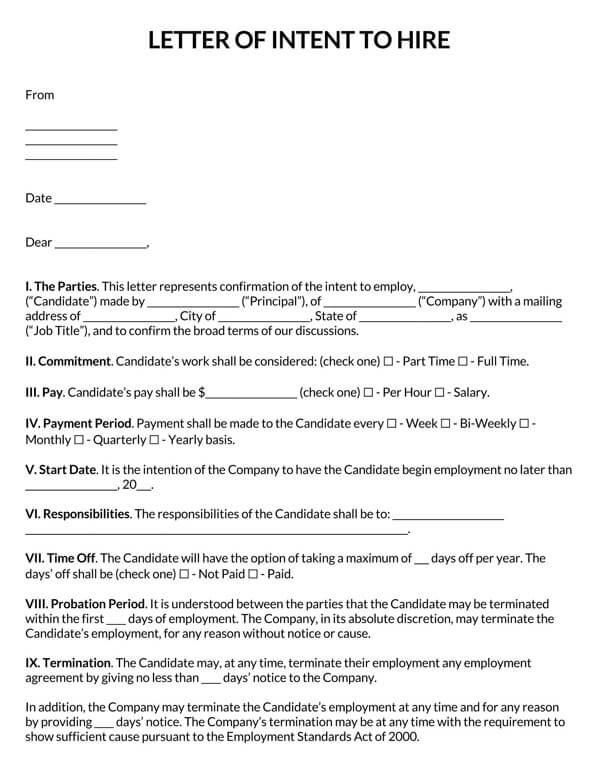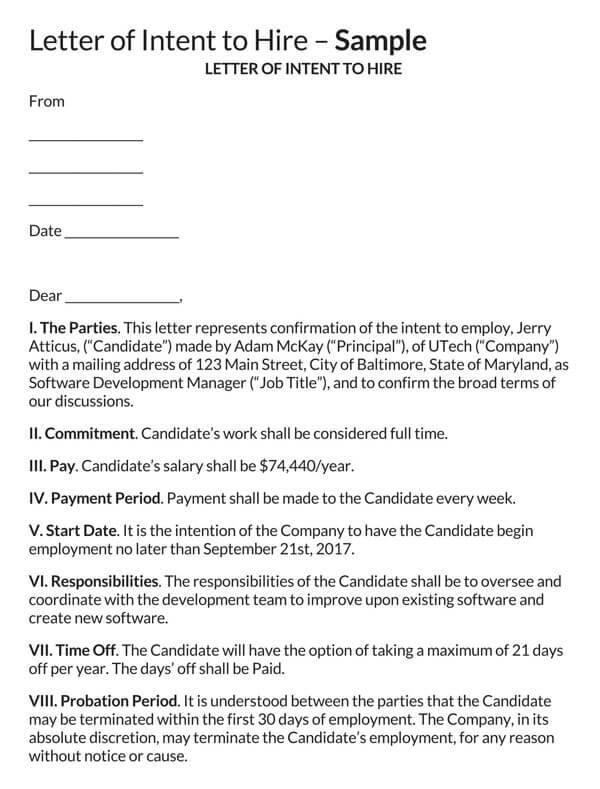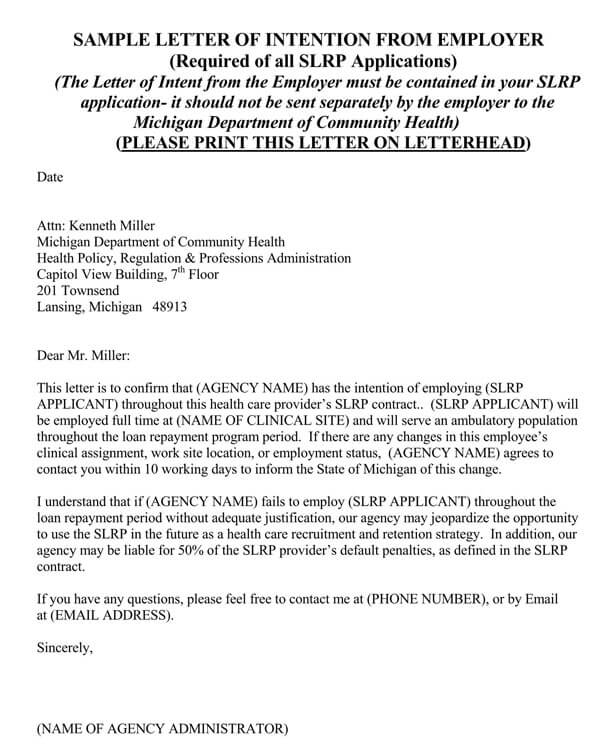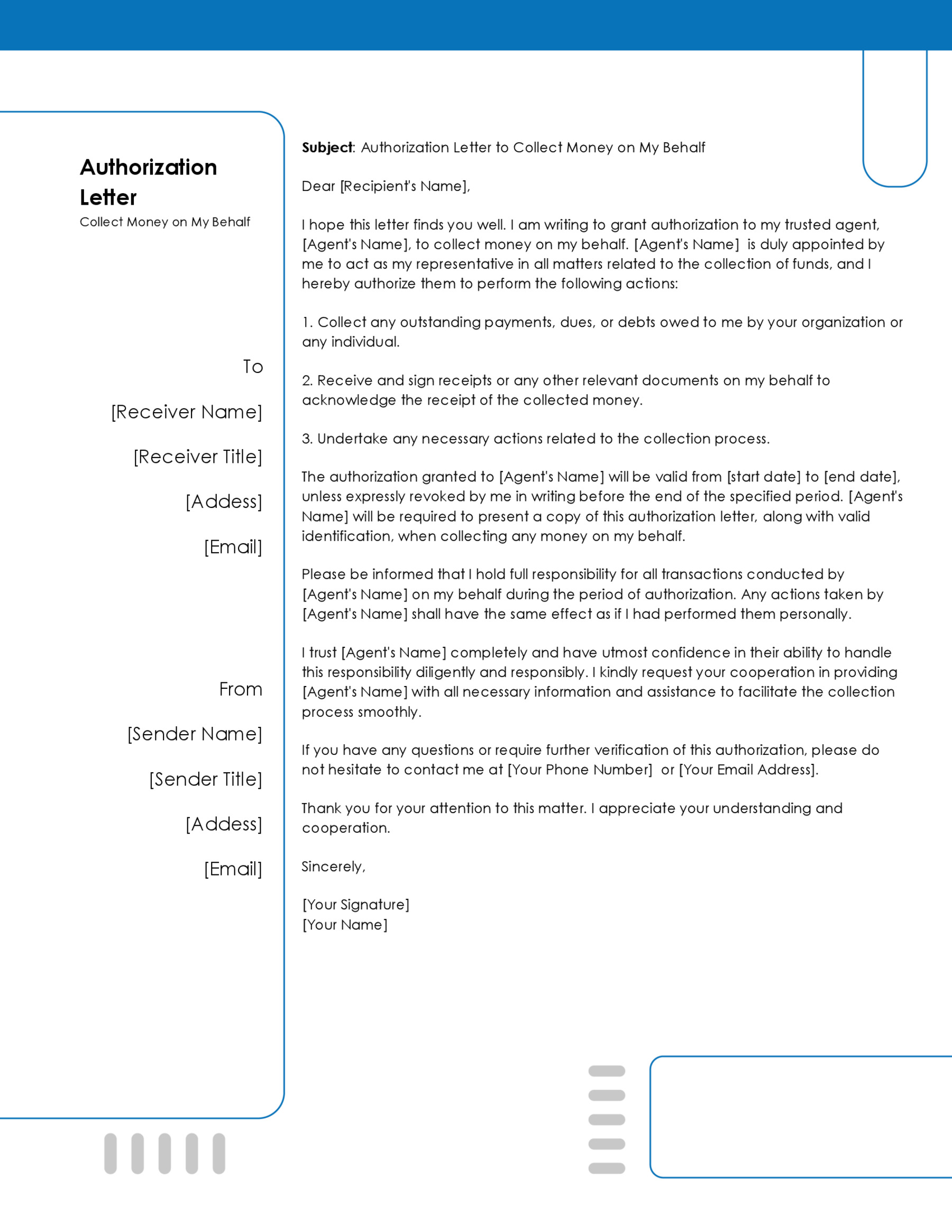A letter of intent to hire is a formal letter sent by an employer to a candidate who has applied for a specific position in the company, business, or organization.
It informs the applicant that they have a chance at getting the vacant position.
Free Templates



Purposes of Sending a Letter of Intent to Hire
Employers are tasked with reviewing hundreds of applications when searching for a suitable candidate to occupy a vacant position. Once employers have identified interested candidates, they should send this letter.
It will serve the following purposes:
- Seek to find out if a candidate is still interested in the position or if they have already found a job.
- It will inform candidates to stop their active job search as they are being considered for the position.
- It will provide candidates with guidelines to secure the position,
EXAMPLE
Attend an interview, send specific documentation, provide references for verification of the candidate’s credentials, etc.
- It will also provide candidates with other vital details about the position being offered,
EXAMPLE
The employer’s monthly salary, the candidate’s delegated duties and responsibilities, the start date, and other terms and conditions associated with the job.
It acts as an almost informal commitment between the employer and the candidate. It can also be considered a crucial first step towards an employment agreement because it helps ensure the employer conveys detailed information concerning a candidate’s employment terms.
Writing a Letter of Intent
When writing it, employers should ensure that they provide all the relevant information concerning the position. It is therefore critical that the employer ensure the letter is well composed.
The following is a step-by-step guide on how to write it:
Sender’s information
Employers should start by providing information regarding them and the company. The information provided must include the employer’s name and the name, and address of the company. The sender’s information helps the applicant identify who is sending the letter. This is important because applicants often send job applications to multiple companies.
Date
Secondly, the employer must indicate the effective date on the letter. The date is a record of the employer’s correspondence to the candidate. The data was communicated to the recipients when the employer wrote it to give them time to respond to the employer.
Recipient’s information
Thirdly, the employer must indicate the applicant’s information. This information includes the applicant’s name and contact information. By indicating the recipient’s information, the employer identifies who they are addressing and nominating for the specified position.
Body of letter
Next, it must contain certain key elements to effectively communicate its message to the candidate.
These fundamental elements include:
The parties
Employers should start the body of the letter by mentioning the names of anyone involved in the letter, which includes their name and that of the candidate. Stating the parties involved ensures clarity is established as to whom it is meant for.
Commitment
The employer should then state whether the candidate’s job will be full-time or part-time. This will help the employer declare the commitment level expectations of the job for the candidate to decide if it suits their lifestyle.
EXAMPLE
Candidates with kids may opt to work part-time to enable them to designate time to spend with their children. By declaring their expectations, employers could avoid a situation where employees may complain about being overworked.
Pay
The employer should provide further information indicating the salary and benefits the applicant will receive for the position. The employer should indicate the amount in both numbers and words.
Payment period
The employer should also mention the frequency of salary payments to the candidate.
EXAMPLE
A company’s payment duration may be weekly, monthly, or yearly.
Starting date
The employer should also ensure that the letter mentions the specific date of commencement of the applicant’s employment, should they be hired for the job.
Responsibilities
It should also outline all the duties and responsibilities of the applicant who occupies the position;
EXAMPLE
As a graphic designer, the applicant will be responsible for developing content, designing graphics and layouts for product illustration, etc.
Again, this helps the employer avoid any future inconveniences caused by a lack of clarity.
Time off
The employer must make sure that the letter indicates the conditions under which the potential employee will be allowed time off and the amount of time the candidate can take. Employers must also mention whether the time off will be paid or unpaid to ensure that candidates agree to the set term.
Probation period
A probationary period is a trial period that new employees serve to enable the employer to get acquainted with them. The probation period lets the employer decide whether to offer the new employee a regular or permanent position. If an employer finds the new employee’s work unsatisfactory, they can terminate employment with or without notice, depending on company policy. It must indicate the time frame of the probationary period.
Termination
The employer must ensure that it contains a termination clause in line with the company policy. The termination clause must state any employee’s procedural expectations that intend to terminate their employment and the procedures of the company when or if terminating the employee, such as a notice period. The information should also include situations that may lead to employment termination.
Non-compete
The employer must also ensure that the letter contains the non-compete clause if any. A non-compete clause prohibits a company’s former employee from working for its competitors for a given period. This clause acts as a temporary injunction preventing former employees from sharing confidential information or trade secrets acquired during their tenure in a company. It must indicate the time frame of the effectiveness of the non-compete policy.
Binding effect
It must clearly state whether it is binding or non-binding. The employer must use straightforward language to ensure that this is communicated to the applicant.
Additional terms and conditions
The employer must ascertain that the letter mentions any other terms and conditions, such as a specific dress code for all company employees that the applicant must know before signing the document.
Company information
Employers should follow up by ensuring that it contains their signature, printed name, and date. This certifies that the employer has provided all the necessary information to the applicant.
Sender’s signature
Finally, the letter should be concluded with the sender’s signature, printed name, and date. The sender’s signature verifies that they wrote or acknowledges and agrees with the letter’s contents.
Letter of Intent to Hire Template
[Your Company Letterhead]
[Date]
[Applicant’s Name]
[Applicant’s Address]
[City, State, Zip Code]
Dear [Applicant’s Name],
Subject: Letter of Intent to Hire
We are delighted to inform you of our intent to offer you the position of [Position Title] at [Company Name], subject to the completion of certain pre-employment conditions. Your unique blend of skills, experience, and dedication has impressed us, and we believe that you would be a valuable addition to our team and contribute significantly to our ongoing projects and future endeavors.
Position Overview:
- Job Title: [Position Title]
- Department/Team: [Department/Team Name]
- Reporting To: [Supervisor/Manager’s Name]
- Location: [Office Location/Remote/ Hybrid]
- Proposed Start Date: [Tentative Start Date]
About the Role:
Your role as [Position Title] is envisioned to encompass a range of responsibilities that are vital to our operations and strategic goals. While a detailed job description will be provided in the formal offer letter, your primary duties will include:
[Briefly outline key responsibilities, e.g., managing projects, developing strategies, leading a team, etc.]
Compensation and Benefits Preview:
We are committed to offering our employees a competitive compensation package and a supportive work environment. The specifics of your salary, benefits, and other terms of employment will be detailed in the forthcoming offer letter. However, we anticipate offering:
- Salary: An attractive package commensurate with your experience and the standards of our industry.
- Benefits: [General mention of benefits, e.g., health insurance, retirement plans, etc.]
Please note, that this letter of intent is not an employment contract but a precursor to a formal job offer. The offer will be subject to:
- Successful completion of [background checks/reference checks/any other pre-employment screenings].
- Review and agreement of formal employment terms outlined in the offer letter.
We kindly ask for your acknowledgment of this letter by [response deadline], indicating your preliminary acceptance and understanding that this is part of the process leading to a formal employment offer. Your response can be directed to [Contact Person’s Name] via email at [Contact Email] or phone at [Contact Phone Number].
We are excited about the possibility of you joining our team and look forward to your positive response. Should you have any questions or need further clarification, please do not hesitate to reach out to us.
Thank you for considering this opportunity with [Company Name]. We believe in your potential to contribute to our success and are eager to support your professional growth within our company.
Warm regards,
[Your Name]
[Your Job Title]
[Company Name]
[Contact Information]
Letter of Intent to Hire Sample
Dear Jane Doe,
Subject: Letter of Intent to Hire
We are thrilled to extend to you this letter of intent to hire for the position of Marketing Manager at XYZ Corporation, contingent upon the successful completion of our standard pre-employment screening processes. Your expertise in strategic marketing, combined with your innovative approach to digital campaigns, has left a lasting impression on our selection team. We are confident in your ability to contribute significantly to our marketing department and to play a key role in achieving our company’s strategic goals.
Position Overview:
- Job Title: Marketing Manager
- Department/Team: Marketing Department
- Reporting To: Director of Marketing
- Location: Anytown Office / Remote Flexibility
- Proposed Start Date: April 15, 20XX
As Marketing Manager, you will be at the forefront of developing and executing our marketing strategies to enhance our market presence and drive our company’s growth. While a comprehensive job description will be detailed in the forthcoming formal offer letter, your core responsibilities will include:
- Leading the planning and implementation of marketing campaigns.
- Managing the marketing team to achieve departmental goals.
- Collaborating with other departments to ensure a cohesive brand message.
- Overseeing the company’s digital presence and content strategy.
XYZ Corporation is committed to offering a competitive compensation package that includes:
- Salary: A competitive annual salary, reflective of your experience and our industry standards.
- Benefits: A comprehensive benefits package including health, dental, and vision insurance, a 401(k) retirement plan, and generous paid time off.
This letter of intent is not an employment contract but signifies our intention to proceed with a formal job offer, subject to the satisfactory completion of our pre-employment checks. We kindly request your preliminary acceptance of this intent by March 11, 20XX. Please direct your response and any inquiries to myself via email at john.smith@xyzcorporation.com or by phone at (555) 123-4567.
We are enthusiastic about the prospect of you joining our team and are confident in the value you will bring to XYZ Corporation. Should you have any questions or require further details, please feel free to reach out.
Thank you for considering this opportunity with us. We are hopeful for your positive response and eagerly anticipate the possibility of welcoming you to our team.
Warmest regards,
John Smith
Director of Human Resources
XYZ Corporation
john.smith@xyzcorporation.com
(555) 123-4567
Analysis
This letter of intent to hire effectively communicates a job offer to a candidate with clarity and enthusiasm. Beginning with an expression of excitement regarding the candidate’s potential at XYZ Corporation, it creates a welcoming tone. The letter outlines the Marketing Manager position, including job responsibilities and the strategic importance to the company, which provides the candidate with a clear understanding of the role. Additionally, it details the competitive compensation and benefits package, emphasizing the company’s commitment to employee welfare and the value it places on the candidate’s expertise.
Crucially, the letter clarifies that this communication is an intent to hire contingent upon pre-employment screening, rather than a binding employment contract, managing legal and expectation-related aspects efficiently. It requests a preliminary acceptance from the candidate, offering direct contact information to facilitate further discussion. This approach not only keeps the communication lines open but also expresses eagerness to move forward with the hiring process.
Overall, the letter combines professionalism with a personal touch, succinctly conveying job details, expectations, and next steps, making it an effective preliminary step in the hiring process.
Frequently Answered Questions
A letter of intent and an offer letter may be used by companies interchangeably. However, whether to send an offer letter or not depends on the legal limitations concerning when an employer can send an offer letter or if the employer has conclusively decided on all the details concerning the vacant position.
An employer’s capability to de-commit from a signed letter of intent depends on whether it is binding or non-binding. If the language in the letter indicates that it is non-binding, then one can de-commit after signing; however, if the language states otherwise, one cannot de-commit after signing.
It is often considered a non-binding offer. However, it does become binding once an employment contract between an employer and an applicant is signed.












